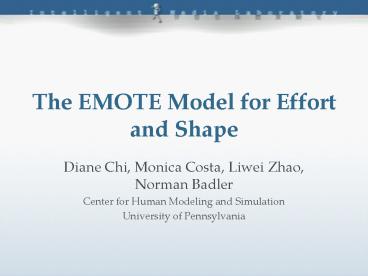The EMOTE Model for Effort and Shape - PowerPoint PPT Presentation
1 / 22
Title:
The EMOTE Model for Effort and Shape
Description:
'Gesture is any movement of any body part in which Effort or ... Horizontal, Vertical, Sagittal. Reach Space. Expressive Arms. Keypoints: end-effector positions ... – PowerPoint PPT presentation
Number of Views:119
Avg rating:3.0/5.0
Title: The EMOTE Model for Effort and Shape
1
The EMOTE Model for Effort and Shape
- Diane Chi, Monica Costa, Liwei Zhao, Norman
Badler - Center for Human Modeling and Simulation
- University of Pennsylvania
2
Outline
- Introduction
- Background
- Expressive Arms
- Expressive Torso
- Examples
3
Introduction
- McNeils gesture model
- Use human observers to manually note and
characterize a subjects gestures - The difficulty is hidden within the decision to
call something a gesture.
4
Introduction (cont.)
- Gesture is any movement of any body part in
which Effort or Shape elements or combinations
can be observed. - Laban Movement Analysis (LMA)
- Approach
- Sequence and phrasing
- Spreading to the whole body
5
Background
- LMA by Rudolf Laban (1879 1958)
- Body
- The parts of the body used
- Space
- Locale, directions, paths
6
Background (cont.)
- Shape
- Bodys changing form
- Effort
- How body concentrates its exertion
- Relationship
- Modes of interaction with oneself, others, and
the environment
7
Effort Elements
8
Shape Components
- Shape Dimensions
- Horizontal, Vertical, Sagittal
- Reach Space
9
Expressive Arms
- Keypoints end-effector positions
- Global vs. Local
- Goal vs. Via
- Arm model
10
Applying Shape to Arm Movements
- Reach Space
- Moving along the path through the keypoint and
the center of mass of the human figure
11
(No Transcript)
12
(No Transcript)
13
Trajectory Definition
- Path curvature by Tval -1, 1
- Interpolation Space
- End-effector position default
- Joint angle free
- Elbow position indirect
14
Parameterized Timing Control
- s 0,1 interpolation parameter over the
interval from keypoint i to keypoint i1 - P(s,i) trajectory function
- t 0,1 relative time between keypoints
15
Parameterized Timing Control (cont.)
- Q(t, I ) s
- Parameters
- Number of frames between keypoints
- I inflection time ti, time exponent texp, start
velocity v0, and end velocity v1
16
Q is the integral of v
17
Flourishes
18
Parameter Settings
19
Expressive Torso
20
Examples
- http//hms.upenn.edu/software/EMOTE/media.html
21
Comment
22
Q AThank you!































